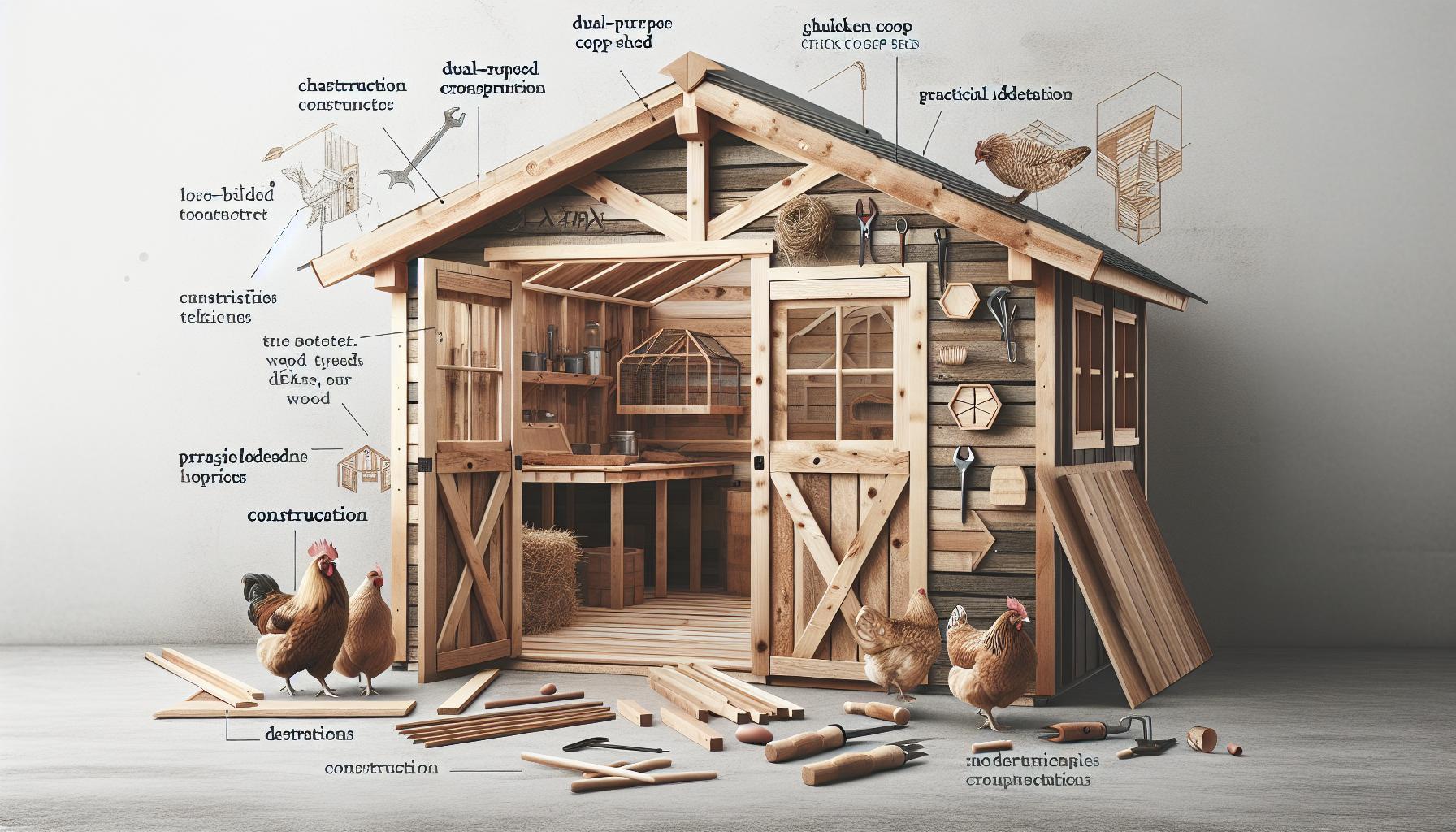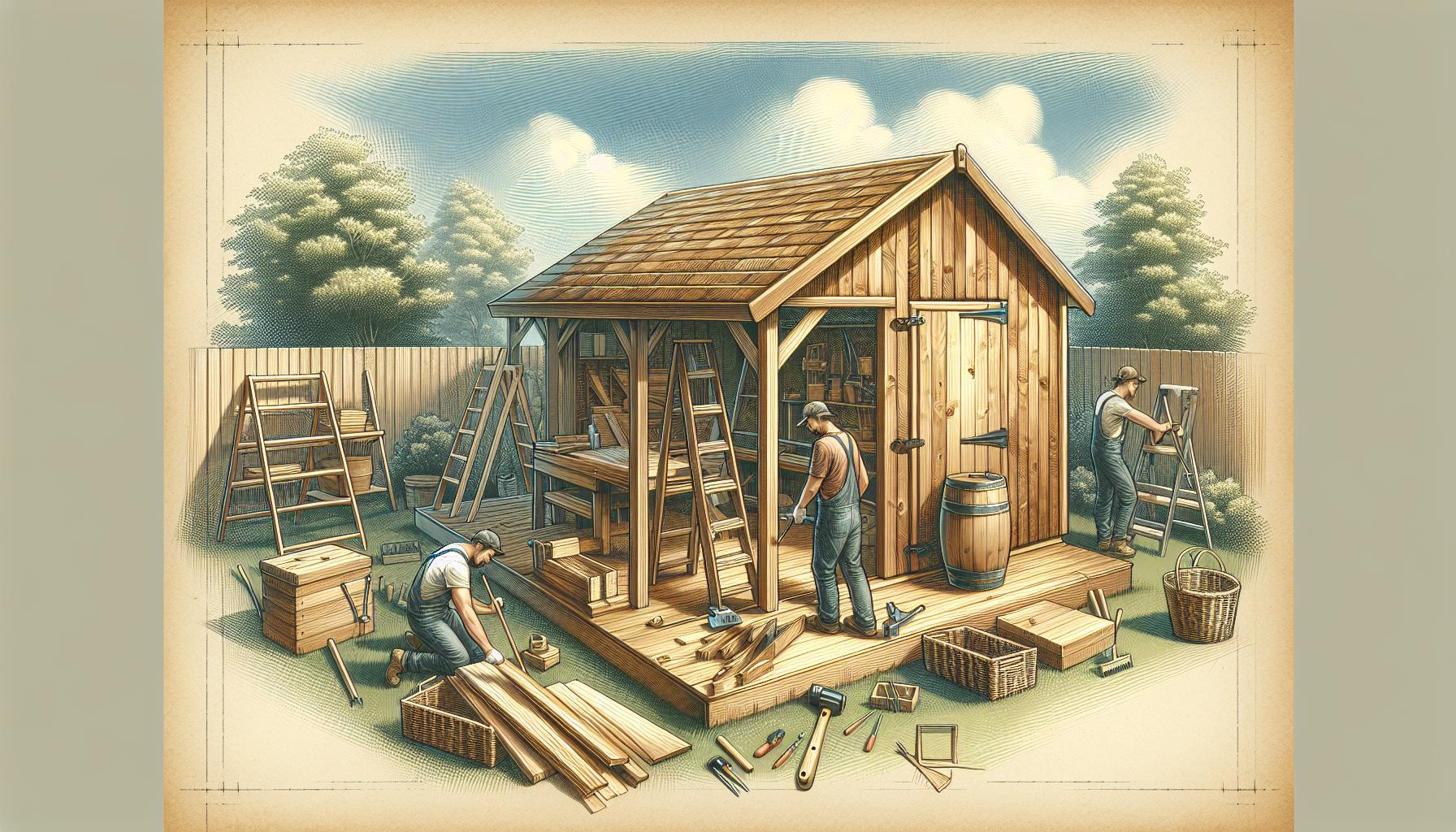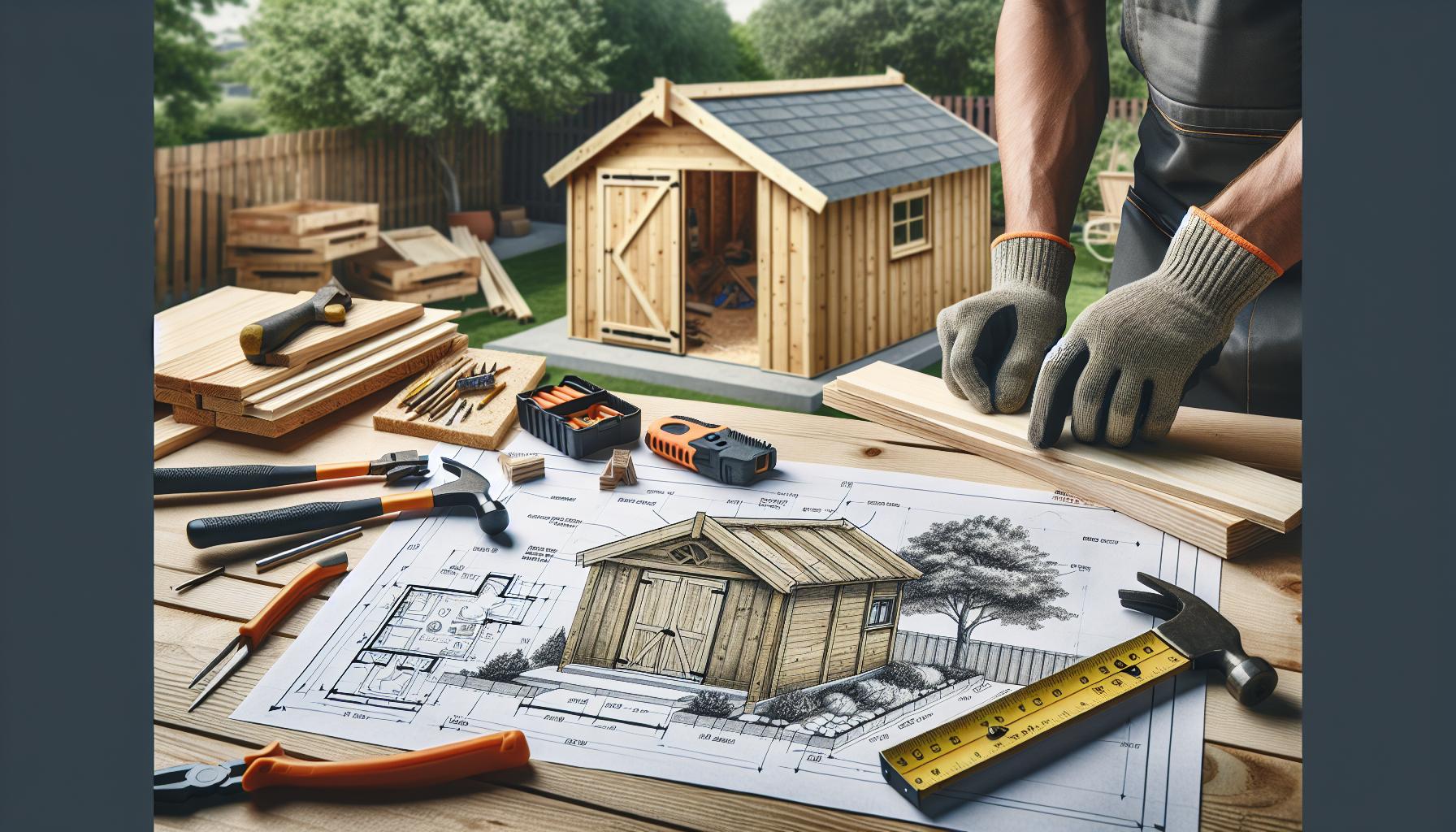Are you looking to maximize your homestead’s functionality while providing a safe haven for your chickens? Building a dual-purpose chicken coop shed can solve space challenges and enhance your gardening efforts. This guide will walk you through the essential steps to create an efficient and attractive structure, ensuring your feathered friends thrive while adding value to your property.
Key Principles of Designing for functionality and Comfort
Designing a chicken coop that effectively caters to both functionality and comfort can significantly enhance the well-being of your flock and the efficiency of your gardening or homesteading operations. An ideal chicken coop shed should seamlessly blend the needs of the chickens with practical features for the caretaker. Understanding the key principles of this dual-purpose design will ensure a thriving environment for your hens while also providing you with ease of management.
Maximizing Space and Layout
A well-planned layout is crucial for ensuring that both the chickens and the caretaker can operate without hindrance. Consider the following elements when designing your coop:
- Nesting areas: designate a quiet and dark space for nesting boxes to encourage laying.
- Roosting bars: Install sturdy roosts at varying heights; chickens love to perch!
- Ventilation: Ensure proper airflow to maintain a healthy environment, preventing moisture buildup and potential respiratory issues.
- Easy access: Include large doors and accessible nesting boxes for fast egg retrieval and cleaning.
Utilizing vertical space is also beneficial. Consider adding shelves or upper storage areas for feed and equipment to keep the floor clear and clean.
Comfort Factors
Chickens thrive in comfortable conditions, which significantly influences their laying and overall health. When figuring out how to build a chicken coop shed, focus on these comfort-oriented features:
- Insulation: In colder climates, insulating the coop will help maintain a stable temperature.
- Sunlight exposure: Incorporate windows to provide natural light and warmth,ensuring your hens have a shining place to thrive.
- Ground cover: Use straw or wood chips in the run area to provide a soft surface for your chickens to walk on.
Implementing natural materials in both the coop’s structure and interior will not only enhance comfort but also contribute to a more aesthetically pleasing environment.
Maintenance and Dual Functionality
A functional coop design must also streamline maintenance tasks. This dual-purpose approach can extend to your gardening needs.Here are some strategies to consider:
| Feature | Benefit |
|---|---|
| Removable floor panels | Simplifies cleaning and composting chicken waste for garden use |
| Integrated storage | Holds gardening supplies and feed in one accessible location |
| Compost bins | Allows space for recycling chicken waste into valuable garden compost |
By designing with these factors in mind, your chicken coop can become a hub of productivity—supporting your flock’s needs while offering convenience for your gardening endeavors. Take these principles into account as you embark on your journey of learning how to build a chicken coop shed, ensuring a dual-purpose haven for both hens and homesteaders alike.
Essential Materials and Tools for Your Coop shed Project
Creating a functional and durable chicken coop shed requires careful consideration of the materials and tools that will form the backbone of your project. Selecting the right items not only ensures that your coop is secure and efficient but also enhances its longevity and usability. Whether you’re new to building or an experienced DIYer, having a well-thought-out list of essentials is key to success in your homesteading journey.
Materials You’ll Need
When embarking on a coop shed project, it’s crucial to gather quality materials that can withstand the elements and provide a safe environment for your chickens. Here’s a list of essential materials you should consider:
- Pressure-treated lumber: Ideal for the frame and floor,as it resists decay and provides strength.
- Plywood or OSB: Used for walls and roofing; opt for exterior-grade to ensure durability.
- Hardware cloth or chicken wire: Necessary for windows and ventilation areas to keep predators out.
- Insulation: If you live in an area with extreme temperatures, add insulation to keep your chickens comfortable year-round.
- Roofing material: Metal or shingles to protect the coop from rain and snow.
- Nails, screws, and brackets: Essential for assembly; use sturdy rust-resistant options for exterior sections.
- Paints and sealants: Non-toxic products will protect the wood and ensure safety for your birds.
Tools Required for Construction
Equally importent to having the right materials is having the appropriate tools on hand. A good selection of tools can simplify the building process and help achieve a professional finish. Below are the must-have tools for your coop shed project:
- Measuring tape: Accurate measurements are crucial for a well-fitted structure.
- Level: To ensure your coop is constructed evenly and sits flat.
- Chop saw or circular saw: Ideal for cutting lumber to the desired lengths and angles.
- Drill: For creating pilot holes and securing screws; a cordless model can enhance flexibility.
- Hammer: A reliable hand tool for driving nails and adjusting materials.
- Safety gear: Don’t forget goggles and gloves to protect yourself while building.
This foundational knowledge on materials and tools is imperative for anyone looking to successfully execute a project centered around effectively building a chicken coop shed, especially one designed with dual purposes for homesteaders. ensure that you take adequate time to select high-quality materials and have all necessary tools ready, which will ultimately make your building experience smoother and more enjoyable.
Step-by-Step Guide: Building Your Chicken Coop Shed
Creating a chicken coop shed can be a rewarding project that not only provides a home for your avian companions but also serves as additional storage or a workspace. By following a clear step-by-step approach, you can efficiently convert a simple shed into a functional dual-purpose structure that meets your needs and ensures your chickens are safe and comfortable.
Assessing Your Shed’s Potential
Before diving into construction, take the time to evaluate your existing shed. Check for structural integrity and assess its suitability for housing chickens. Ensure the dimensions are adequate to provide enough space for roosts, nesting boxes, and movement.A good rule of thumb is to allow at least 4 square feet per chicken inside the coop. Make necessary repairs to the floor, walls, and roof to ensure a secure and lasting environment for your birds.
Designing the Layout
Once you’ve confirmed that your shed is fit for change, plan the interior layout. Consider the following essential features to include:
- nesting Boxes: These should be easily accessible. Aim for one nesting box for every three to four hens.
- Roosting Bars: Chickens prefer to sleep off the ground. Install horizontal bars at varying heights to accommodate different ages and sizes.
- Ventilation: Proper airflow is critical. Install windows,vents,or even small fans to keep the air fresh and prevent moisture buildup.
- Feeding Stations: Designate a clean area for food and water. Consider using feed bins that deter pests.
Ensuring Safety and Comfort
Protection from predators is paramount when building your chicken coop shed. Reinforce any openings with sturdy wire mesh or chicken wire, and ensure that there are no gaps where animals could enter. Additionally, consider a solid floor option and bury fencing below ground level to prevent digging predators. Insulate the coop for winter months, using straw, hay, or suitable materials to keep your chickens warm during colder whether.
Final Touches
After the construction is complete, add finishing touches to enhance usability and comfort. painting the exterior can protect the wood and make your coop visually appealing. Incorporate landscaping around the coop to enrich the environment for your chickens and improve aesthetic value.remember to include easy access points for cleaning and maintenance, ensuring that your chickens stay healthy and happy in their new space.
By following this guide,you’re well on your way to building a chicken coop shed that not only fulfills the needs of your flock but also optimizes your space efficiently. Enjoy the process of creating a sustainable habitat for your feathered friends!
Integrating sustainable Practices in Your Coop Design
integrating sustainable practices into your chicken coop design not only benefits the environment but also fosters a thriving habitat for your flock. To create a sustainable chicken coop that aligns with the principles of dual-purpose design,consider materials and processes that minimize waste and energy consumption. Utilizing recycled or upcycled materials is a foundational approach that can significantly reduce your environmental footprint while together adding character and uniqueness to your structure.
Smart Material Choices
Choosing environmentally friendly materials is essential in crafting a sustainable chicken coop shed. here are some recommendations:
- Recycled Wood: Use reclaimed wood from old pallets,barns,or fences. This not only cuts costs but also diverts waste from landfills.
- Eco-Friendly Paint: Opt for non-toxic, low-VOC (volatile organic compounds) paints and finishes that minimize harmful emissions.
- Natural Insulation: Consider using straw bales, sheep’s wool, or other natural insulation materials that enhance energy efficiency and create a comfortable environment for your chickens.
Energy efficiency
To optimize energy use within your coop, incorporate designs that harness natural resources. Strategically place windows for maximum sunlight exposure, reducing the need for artificial lighting during the day.Additionally, implementing a rainwater collection system can provide a natural water source for your chickens, promoting sustainability.Utilizing solar panels can also be an excellent investment for powering any electrical needs, such as automatic door mechanisms or lighting.
Encouraging Mobility and Rotation
One innovative way to enhance sustainability is by designing a mobile coop that allows you to rotate your chickens around your yard. This method, known as “chicken tractors,” keeps chickens on fresh grass while minimizing overgrazing and soil depletion. It also promotes healthier diets for your flock,as they can forage for insects and foliage,thereby reducing feed costs.By integrating this type of design into your plans for a chicken coop shed, you ensure that your system supports both the land and your poultry’s wellbeing.
By thoughtfully merging sustainable practices with the design of a dual-purpose chicken coop shed,you not only create a functional and efficient space for your flock but also contribute positively to the environment. These considerations will not only make your homesteading experience more rewarding but also create a legacy of stewardship for future generations.
Outdoor Space Considerations: Fencing and Free-Range Options
When establishing a thriving outdoor environment for your chickens, one of the most critical aspects is the choice of fencing and free-range space options. A well-designed fence not only secures your flock from predators but also defines their roaming space, allowing them to enjoy the outdoors safely. By implementing resilient fencing strategies, you ensure your chickens have the freedom to forage while staying protected.
Choosing the Right fencing Material
The type of fencing you select plays a pivotal role in the overall safety and functionality of your chicken coop setup. Here are some popular fencing materials to consider:
- Wood Fencing: Strong and aesthetically pleasing, wood fencing provides a natural barrier. It’s versatile and can blend seamlessly with your homestead.
- Wire Fencing: Options like chicken wire or hardware cloth are commonly used. While effective against most predators, they should be installed with the proper foundation to prevent digging.
- PVC Fencing: Lightweight and rust-resistant, PVC is an attractive option that doesn’t compromise on durability, making it easier to install and maintain [2].
- Electric Fencing: Adding an electric charge can deter larger predators such as raccoons and foxes, providing an extra layer of security for your chickens.
Deciding on the height and type of fence is crucial, with recommendations often suggesting at least a 6-foot high fence to prevent jumping or flying over.
Free-Range Considerations
Free-ranging your chickens can significantly enhance their quality of life, allowing them to exhibit natural behaviors such as foraging and dust bathing. However, it’s essential to balance this freedom with safety concerns. Here are some tips for creating a safe free-range environment:
- Designated Free-Range Areas: Create specific zones where chickens can roam freely under supervision. This can be achieved with temporary fencing options to rotate their grazing area and preserve grass and soil health.
- Provide Cover and Shelter: Incorporate shrubs, trees, and other forms of natural cover within the free-range area. This allows chickens to hide from predators, making them feel secure while browsing for food.
- Time Management: Establish a routine for free-ranging that aligns with high predator activity times, typically early morning and late afternoon. Supervise your chickens as they roam, allowing them their freedom but keeping an eye out for potential threats.
- Fencing for Free-Range Runs: if allowing for extensive free-ranging is impractical,consider constructing a secure run attached to the chicken coop. This way, chickens can enjoy a larger space without direct exposure to predators.
Incorporating these fencing and free-range strategies will complement the insights from the article on how to build a chicken coop shed, leading to a more successful and enjoyable experience in homesteading. The right setup not only ensures the safety and health of your chickens but also enhances your backyard environment.
Maintaining your Coop Shed for Longevity and Health
To ensure that your coop shed remains a thriving and healthy environment for your chickens, regular maintenance is crucial. A well-maintained structure not only supports the health of your flock but also extends the life of your investment. If you’ve embraced the dual-purpose design for homesteaders, maintaining your coop shed becomes even more pivotal as it serves multiple functions—housing your chickens while potentially offering storage for tools and feed.
Regular Inspections
Performing regular inspections can help identify potential problems before they escalate. Here are key areas to focus on during each check:
- roof Integrity: Look for any leaks or damage that could compromise the living space below.
- Ventilation: Ensure that vents are clear to allow for fresh air circulation, reducing moisture buildup and respiratory issues in your birds.
- Pest Control: Check for signs of infestations, such as droppings or nests, and take corrective actions immediately.
Cleaning and Disinfection
Maintaining a clean environment is essential for preventing disease. Implement a schedule for deep cleaning, including scraping droppings, replacing bedding, and disinfecting surfaces with poultry-safe cleaners. This practice not only prevents the spread of bacteria but also contributes to a more pleasant environment for your chickens and any other activities you may conduct within the shed.
Structural Maintenance
Given the shifting conditions of outdoor environments, your coop shed may require occasional repairs. Use high-quality materials when building or making repairs; this can significantly lower the frequency of maintenance tasks.Consider creating a checklist for structural integrity, including:
- Assessing and repairing any rotting wood or damage from weather.
- Checking doors and windows for proper sealing against predators.
- Ensuring that fencing around your yard remains secure and intact.
Additionally, establishing a maintenance log can be beneficial.Documenting what repairs were made and when they were completed will help you stay organized and proactive in your upkeep efforts.
By committing to these maintenance practices, you ensure your coop shed not only functions as a safe haven for your flock but also continues to serve your homesteading needs effectively for years to come. This dedication to upkeep reflects the principles behind “How to Build a Chicken Coop Shed: Dual-Purpose Design for Homesteaders,” marrying functionality with longevity.
FAQ
How to Build a Chicken Coop Shed: Dual-Purpose design for Homesteaders?
The first step in how to build a chicken coop shed for dual purposes involves planning a layout that accommodates both storage and chickens. Start with assessing your space,determining the coop size based on the number of chickens you’re raising.
use durable materials such as treated wood and weatherproof roofing to ensure longevity. consider adding windows for ventilation and natural light, which are essential for healthy chickens. Plus, think about how you might customize the shed for tools or feed storage.
What are the benefits of a dual-purpose chicken coop shed?
A dual-purpose chicken coop shed maximizes your space, allowing for both chickens and equipment storage. This design is efficient, saving you time and effort in managing your homestead.
In addition to functionality, it contributes to a more organized property. Having a *central location* for your chickens and supplies means less hassle during feeding and maintenance, enhancing your overall homesteading experience.
Can I use recycled materials to build my chicken coop shed?
yes, using recycled materials is a sustainable and cost-effective way to build your chicken coop shed. Items like old pallets,doors,and windows can be transformed into valuable components of your coop.
However, ensure that these materials are in good condition and free from chemicals that could harm your chickens. Properly treated, recycled materials can make an attractive and practical coop.
What size should I build my chicken coop shed?
Your chicken coop shed size depends on the number of chickens you plan to raise. As a rule of thumb, allow at least 4 square feet per chicken inside the coop and 10 square feet per chicken in an outdoor run.
Considering a dual-purpose design, factor in additional space for tools or storage. Planning this ahead will prevent overcrowding and ensure a comfortable environment for your chickens.
How to insulate a chicken coop shed?
Insulating your chicken coop shed is crucial for maintaining a comfortable environment in both summer and winter. Use materials like foam board insulation and fiberglass to insulate the walls and roof.
Additionally, consider ventilated design elements to prevent moisture buildup, which can negatively affect chicken health.Good insulation practices improve energy efficiency and help keep your chickens cozy.
Why does coop ventilation matter in a chicken coop shed?
Proper ventilation in your chicken coop shed is essential to prevent heat buildup, moisture accumulation, and the spread of diseases. It maintains a fresh air supply necessary for healthy chicken respiratory systems.
Incorporate windows, vents, or a fan system to enhance airflow. This is particularly important during hot months and helps reduce the risk of respiratory infections caused by stagnant air.
How to ensure my chicken coop shed is predator-proof?
Making your chicken coop shed predator-proof is key to keeping your flock safe.Use robust materials for the coop, such as reinforced wire fencing and strong locks.
additionally,bury wire fencing below ground to deter digging predators. Regularly inspect your coop for vulnerabilities, as maintaining a secure environment is necessary for the well-being of your chickens.
Closing Remarks
building a chicken coop shed that serves dual purposes offers an enriching experience for homesteaders, blending functionality with creativity. By incorporating features that not only house your chickens but also serve as storage or a workspace, you optimize your backyard space effectively. Remember to prioritize sturdy materials to ensure safety and durability, as well as proper ventilation to create a healthy environment for your flock.
As you embark on this project, it’s crucial to consider local zoning laws and regulations regarding chicken keeping, ensuring compliance before construction begins. Utilize design inspiration from fellow homesteaders, and don’t hesitate to share your journey—documenting your progress can motivate others and cultivate a supportive community around this rewarding endeavor.
Whether you’re a seasoned builder or just starting out, remember that the journey is as important as the destination. Embrace the learning curve, and allow your creativity to flourish as you create a space that meets your practical needs while fulfilling your aspiration to live closer to nature. Explore additional resources and designs to enrich your project, and enjoy every step of the process as you contribute to the sustainable lifestyle movement. Happy building!






